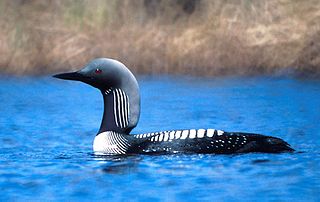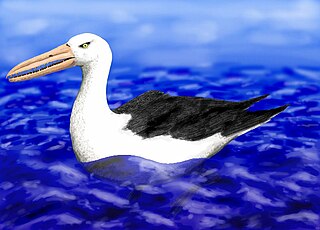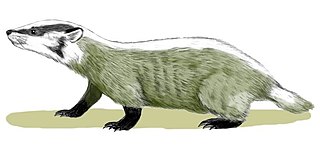
Gaviiformes is an order of aquatic birds containing the loons or divers and their closest extinct relatives. Modern gaviiformes are found in many parts of North America and northern Eurasia, though prehistoric species were more widespread.

Loons or divers are a group of aquatic birds found in much of North America and northern Eurasia. All living species of loons are members of the genus Gavia, family Gaviidae and order Gaviiformes.

Osteodontornis is an extinct seabird genus. It contains a single named species, Osteodontornis orri, which was described quite exactly one century after the first species of the Pelagornithidae was. O. orri was named after then-recently deceased naturalist Ellison Orr.

Chamitataxus is a prehistoric badger genus. Chamitataxus avitus is the only known species of the genus. Chamitataxus lived during the Late Miocene, around 6 million years ago in what is now North America. Out of the three taxideine badger genera to have existed on the continent, Chamitataxus is the most primitive. Very few taxideine badger remains have been uncovered to date, with only prehistoric Taxidea and Pliotaxidea specimens being discovered prior to the Chamitataxus holotype being found.

Pelagornis is a widespread genus of prehistoric pseudotooth birds. These were probably rather close relatives of either pelicans and storks, or of waterfowl, and are here placed in the order Odontopterygiformes to account for this uncertainty.
Pseudodontornis is a rather disputed genus of the prehistoric pseudotooth birds. The pseudotooth birds or pelagornithids were probably rather close relatives of either pelicans and storks, or of waterfowl, and are here placed in the order Odontopterygiformes to account for this uncertainty. Up to five species are commonly recognized in this genus.

Thecachampsa is an extinct genus of gavialoid crocodylian, traditionally regarded as a member of the subfamily Tomistominae. Fossils have been found from the eastern United States in deposits of Miocene age. Those named in the 19th century were distinguished primarily by the shape of their teeth, and have since been combined with T. antiquus. More recently erected species were reassigned from other genera, although their assignment to Thecachampsa has since been questioned.
Pelecanus schreiberi is a fossil pelican described by Storrs Olson from Early Pliocene deposits in the Yorktown Formation of North Carolina. It was a large species with distinctive features suggesting that it represents an extinct lineage with no living descendants. The specific epithet commemorates Ralph W. Schreiber (1942–1988), a former curator of birds at the Natural History Museum of Los Angeles County and an authority on pelicans.

Spheniscus muizoni is an extinct species of banded penguins that lived during the early Late Miocene in what is now Peru, South America. The species, the earliest member of the extant genus, was described in 2007 by Ursula B. Göhlich based on fossils found in the fossiliferous Pisco Formation of the Pisco Basin, southwestern Peru.
Patagorhacos is an extinct genus of medium-sized phorusrhacid from the early Miocene of Patagonia. Currently only the single species Patagorhacos terrificus is known, which is represented by two highly fragmentary specimen, one belonging to the back of the skull and the other being the distal end of a leg bone. It was described together with the contemporary rheid Opisthodactylus horacioperezi.
Rhea mesopotamica is an extinct species of bird in the genus Rhea, whose living species are known as suris, rhea, or choiques. It lived in the Southern Cone of South America.
Annakacygna is a genus of flightless marine swan from the Miocene of Japan. Named in 2022, Annakacygna displays a series of unique adaptations setting it apart from any other known swan, including a filter feeding lifestyle, a highly mobile tail and wings that likely formed a cradle for their hatchlings in a fashion similar to modern mute swans. Additionally, it may have used both wings and tail as a form of display. All of these traits combined have led the researchers working on it to dub it "the ultimate bird". Two species are known, A. hajimei, which was approximately the size of a black swan, and A. yoshiiensis which exceeded the mute swan in both size and weight. The describing authors proposed the vernacular name Annaka short-winged swan for the genus.
Phocavis is an extinct genus of flightless seabird, belonging to the family Plotopteridae, and distantly related with modern cormorants. Its fossils, found in the Keasey Formation in Oregon, are dated from the Late Eocene.
Gavia howardae is an extinct species of loon from the Piacenzian age from United States. Fossils of this bird were initially found in 1947 by Clifford Kennell in the San Diego Formation, California and were given a name in 1953 by Pierce Brodkorb. These first specimens consisted of humeri bones, which Brodkorb indicated based on the distal end of the humerus were a smaller species of the genus Gavia, with a possible relationship with the pacific loon. More specimens were collected from the same deposits covering the entirety of the wing, some more complete than others. Chandler (1990) described and published these new materials and found G. howardae to be related to the red-throated loon instead. Additional material has been recovered from the Yorktown Formation, North Carolina where in addition more wing bones, there were also remains of the leg and shoulder regions. Based on the overall size of the remains, G. howardae was on average smaller than the red-throated loon, and one of the smallest species of Neogene loons from North America.
Gavia fortis is an extinct species of loon from the Zanclean age from United States. Fossils of this bird have mostly been found in the Yorktown Formation from North Carolina and two specimens recovered from the Bone Valley Formation in Florida. Remains of this species is mostly the bones that make up the wing, the synsacrum, the legs and feet. Olson & Rasmussen who described the species in 2001 noted that the bones are markedly more robust, indicating this is the third largest species of loon to have existed, after the common loon and the yellow-billed loon. The authors believed G. fortis is indeed close to the ancestor of both of the aforementioned extant species.
Gavia brodkorbi is an extinct species of loon from the Clarendonian age from United States. The holotype and only known specimen is a complete left ulna that was collected from the Monterey Formation in Laguna Niguel, California by Marion J. Bohreer in 1969. The ulna is shorter but more stouter in comparison to the red-throated loon and pacific loon. The area of attachment of the ligaments is different from the extant species, as it is shorter and less oval. Hildegarde Howard would described the bird in 1978 on a paper discussing the Late Miocene seabird fauna of Orange County named the species after Pierce Brodkorb for his contribution for the field of paleornithology including his review of Pliocene loons.

Thiornis is a fossil genus of Middle Miocene grebe known from a nearly complete specimen from Libros, Spain. Originally classified as a type of moorhen, Thiornis has since been classified as a species of grebe. The overall anatomy of the bird is identical to modern grebes. It contains a single species, T. sociata.
Podiceps howardae is a possible extinct species of grebe from the United States, possibly a larger and earlier form of the horned grebe.
Podiceps solidus is an extinct small species of Upper Miocene to Lower Pliocene grebe from Western Mongolia.
Gavia moldavica is an extinct species of small Late Miocene loon from Moldova.







